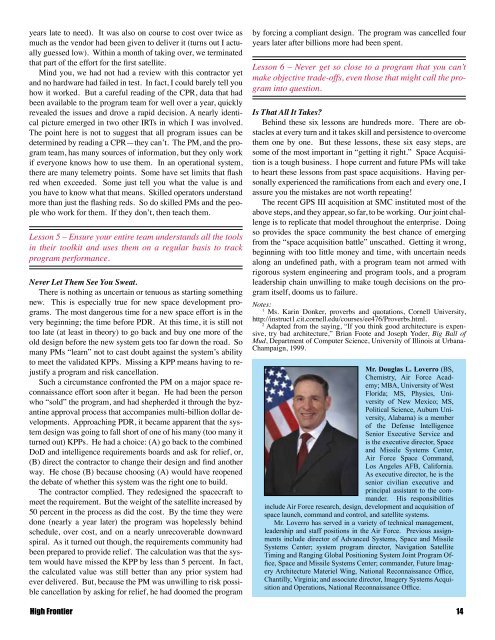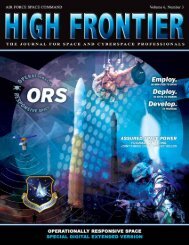Space Acquisition - Air Force Space Command
Space Acquisition - Air Force Space Command
Space Acquisition - Air Force Space Command
You also want an ePaper? Increase the reach of your titles
YUMPU automatically turns print PDFs into web optimized ePapers that Google loves.
years late to need). It was also on course to cost over twice as<br />
much as the vendor had been given to deliver it (turns out I actually<br />
guessed low). Within a month of taking over, we terminated<br />
that part of the effort for the first satellite.<br />
Mind you, we had not had a review with this contractor yet<br />
and no hardware had failed in test. In fact, I could barely tell you<br />
how it worked. But a careful reading of the CPR, data that had<br />
been available to the program team for well over a year, quickly<br />
revealed the issues and drove a rapid decision. A nearly identical<br />
picture emerged in two other IRTs in which I was involved.<br />
The point here is not to suggest that all program issues can be<br />
determined by reading a CPR—they can’t. The PM, and the program<br />
team, has many sources of information, but they only work<br />
if everyone knows how to use them. In an operational system,<br />
there are many telemetry points. Some have set limits that flash<br />
red when exceeded. Some just tell you what the value is and<br />
you have to know what that means. Skilled operators understand<br />
more than just the flashing reds. So do skilled PMs and the people<br />
who work for them. If they don’t, then teach them.<br />
Lesson 5 – Ensure your entire team understands all the tools<br />
in their toolkit and uses them on a regular basis to track<br />
program performance.<br />
Never Let Them See You Sweat.<br />
There is nothing as uncertain or tenuous as starting something<br />
new. This is especially true for new space development programs.<br />
The most dangerous time for a new space effort is in the<br />
very beginning; the time before PDR. At this time, it is still not<br />
too late (at least in theory) to go back and buy one more of the<br />
old design before the new system gets too far down the road. So<br />
many PMs “learn” not to cast doubt against the system’s ability<br />
to meet the validated KPPs. Missing a KPP means having to rejustify<br />
a program and risk cancellation.<br />
Such a circumstance confronted the PM on a major space reconnaissance<br />
effort soon after it began. He had been the person<br />
who “sold” the program, and had shepherded it through the byzantine<br />
approval process that accompanies multi-billion dollar developments.<br />
Approaching PDR, it became apparent that the system<br />
design was going to fall short of one of his many (too many it<br />
turned out) KPPs. He had a choice: (A) go back to the combined<br />
DoD and intelligence requirements boards and ask for relief, or,<br />
(B) direct the contractor to change their design and find another<br />
way. He chose (B) because choosing (A) would have reopened<br />
the debate of whether this system was the right one to build.<br />
The contractor complied. They redesigned the spacecraft to<br />
meet the requirement. But the weight of the satellite increased by<br />
50 percent in the process as did the cost. By the time they were<br />
done (nearly a year later) the program was hopelessly behind<br />
schedule, over cost, and on a nearly unrecoverable downward<br />
spiral. As it turned out though, the requirements community had<br />
been prepared to provide relief. The calculation was that the system<br />
would have missed the KPP by less than 5 percent. In fact,<br />
the calculated value was still better than any prior system had<br />
ever delivered. But, because the PM was unwilling to risk possible<br />
cancellation by asking for relief, he had doomed the program<br />
by forcing a compliant design. The program was cancelled four<br />
years later after billions more had been spent.<br />
Lesson 6 – Never get so close to a program that you can’t<br />
make objective trade-offs, even those that might call the program<br />
into question.<br />
Is That All It Takes<br />
Behind these six lessons are hundreds more. There are obstacles<br />
at every turn and it takes skill and persistence to overcome<br />
them one by one. But these lessons, these six easy steps, are<br />
some of the most important in “getting it right.” <strong>Space</strong> <strong>Acquisition</strong><br />
is a tough business. I hope current and future PMs will take<br />
to heart these lessons from past space acquisitions. Having personally<br />
experienced the ramifications from each and every one, I<br />
assure you the mistakes are not worth repeating!<br />
The recent GPS III acquisition at SMC instituted most of the<br />
above steps, and they appear, so far, to be working. Our joint challenge<br />
is to replicate that model throughout the enterprise. Doing<br />
so provides the space community the best chance of emerging<br />
from the “space acquisition battle” unscathed. Getting it wrong,<br />
beginning with too little money and time, with uncertain needs<br />
along an undefined path, with a program team not armed with<br />
rigorous system engineering and program tools, and a program<br />
leadership chain unwilling to make tough decisions on the program<br />
itself, dooms us to failure.<br />
Notes:<br />
1<br />
Ms. Karin Donker, proverbs and quotations, Cornell University,<br />
http://instruct1.cit.cornell.edu/courses/ee476/Proverbs.html.<br />
2<br />
Adapted from the saying, “If you think good architecture is expensive,<br />
try bad architecture,” Brian Foote and Joseph Yoder, Big Ball of<br />
Mud, Department of Computer Science, University of Illinois at Urbana-<br />
Champaign, 1999.<br />
Mr. Douglas L. Loverro (BS,<br />
Chemistry, <strong>Air</strong> <strong>Force</strong> Academy;<br />
MBA, University of West<br />
Florida; MS, Physics, University<br />
of New Mexico; MS,<br />
Political Science, Auburn University,<br />
Alabama) is a member<br />
of the Defense Intelligence<br />
Senior Executive Service and<br />
is the executive director, <strong>Space</strong><br />
and Missile Systems Center,<br />
<strong>Air</strong> <strong>Force</strong> <strong>Space</strong> <strong>Command</strong>,<br />
Los Angeles AFB, California.<br />
As executive director, he is the<br />
senior civilian executive and<br />
principal assistant to the commander.<br />
His responsibilities<br />
include <strong>Air</strong> <strong>Force</strong> research, design, development and acquisition of<br />
space launch, command and control, and satellite systems.<br />
Mr. Loverro has served in a variety of technical management,<br />
leadership and staff positions in the <strong>Air</strong> <strong>Force</strong>. Previous assignments<br />
include director of Advanced Systems, <strong>Space</strong> and Missile<br />
Systems Center; system program director, Navigation Satellite<br />
Timing and Ranging Global Positioning System Joint Program Office,<br />
<strong>Space</strong> and Missile Systems Center; commander, Future Imagery<br />
Architecture Materiel Wing, National Reconnaissance Office,<br />
Chantilly, Virginia; and associate director, Imagery Systems <strong>Acquisition</strong><br />
and Operations, National Reconnaissance Office.<br />
High Frontier 14











